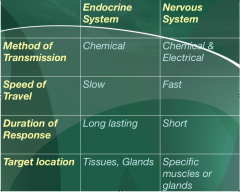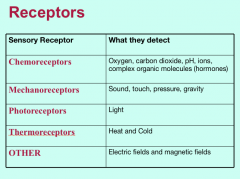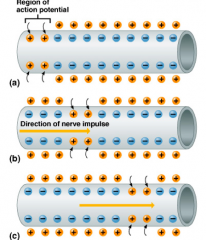![]()
![]()
![]()
Use LEFT and RIGHT arrow keys to navigate between flashcards;
Use UP and DOWN arrow keys to flip the card;
H to show hint;
A reads text to speech;
13 Cards in this Set
- Front
- Back
|
CNS: Central Nervous System - the brain & spinal cord
PNS: Peripheral Nervous System - all other parts of the nervous system NEURONES - nerve cells with extensions called ‘fibres’ MYELIN - whitish fatty material that covers the nerve fibres NODES - small gaps where adjacent myelin cells meet |
IMPULSES: electrical messages that are transmitted along the neurone and is assisted by the myelin sheath
SENSORY NEURONS: send electrical impulses to the CNSMOTOR NEURONS: send electrical impulses from the CNS to the effectors S.A.M.E.Sensory = AffectorsMotor = EffectorsINTERNEURONS: neurons that connect the sensory & motor neuronsAlso called CONNECTING NEURONSFound only in the CNS |
|
|
- Nerve cells contain both positive and negative ions: POSITIVE - Na, K NEGATIVE - Protein - These ions move along the neuron which creates the charge NEURON RESTING - negative charge. High amounts of Na+ outside and Low amounts of K+ inside. KNOWN AS ELECTRICALLY POLARISED |
NEURON STIMULATED - Membrane becomes permeable to Na ions - Neuron becomes depolarised - Neuron in positive inside and negative outside NEURON RELAXES - Neuron becomes repolarised and balance of Na/K is restored. |
|
|
NEUROTRANSMITTERS - Chemicals that are released at the synapse - Found in Synaptic Vesicles. - When the Neuron contraction arrives at the synapse, it stimulates neurotransmitters. - Travel across the synaptic cleft and bind to receptor - Stimulates the next neuron. |
- Once the neurotransmitter has performed its function, it must not continue to stimulate the postsynaptic neurone, so it is deactivated by enzymes and reabsorbed by the presynaptic neurone
- A neuron must reach its active potential to stimulate the next neuron or it will not fire at all. |
|
|
- Acetylcholine – found in nerve-muscle junctions; it can be deactivated by an enzyme; many insecticides work by destroying the enzyme, so that the muscle cells receive continuous signals, resulting in muscle spasms
- Snakes & other venomous animals produce chemicals that block the production of neurotransmitters at synapses - Pain-killing medication block the transmission of impulses from pain receptors |
Caffeine, amphetamines, ecstasy & cocaine all promote the release of noradrenalin, a hormone in response to stress. These drugs act as stimulants.
Opiate drugs (eg; morphine, heroin, codeine) block nerve transmission in sensory pathways on the CNS that signal pain – makes them useful in medicine as pain killers Psychedelic drugs (eg; mescaline, LSD) block reabsorption of the neurotransmitter dopamine. This leads to high levels of dopamine in the brain causing hallucinations. |
|
|
Visual signalling – detected in the form of light energy by specialised receptor cells in the retina of the eye (rods & cones)
Olfactory signalling – detection of smells by the olfactory receptor neurones in the lining of the nose Chemical signalling – Pheromones: chemicals emitted by living organisms to send messages to individuals of the same species; used primarily by insects |
Social pheromones – ants leave pheromone trails to the nest
Sexual pheromones – sex attractants Pheromones in mammals – recognition & response |
|
|
COMPARISON OF NERVE AND HORMONES - Speed of travel - Target location - Duration of response - Medium of transmission The nervous system involves both chemical & electrical transmission. The endocrine system involves only chemical transmission. |

|
|
|
The hypothalamus
- produces some hormones itself and also produces releasing and inhibiting hormones which control the production of other hormones. Pituitary gland - consists of an anterior and posterior lobe. The anterior lobe produces a large number of hormones involved in growth and regulation. The posterior lobe of the pituitary gland acts as a storage reservoir for the hormones produced by the hypothalamus (ADH and oxytocin). |
HORMONES - Transported via the bloodstream - Regulate metabolism and cell functioning - Secreted in small amounts - They do not last long as the liver destroys them. - Long term development e.g testosterone - Organic compounds (protein or lipid) |
|

|
Receptors are specialised molecules capable of receiving and responding to stimuli, such as signalling moleculesSensory receptors convert environmental stimuli into signals in nerves.
|
|

|

|
|
|
- Some painkilling tablets (e.g. codeine), morphine, heroin block the transmission of impulses from sensory pathways of the CNS that signal pain. Thus, they are useful in medicine as effective pain-killers. - Caffeine, amphetamines, ecstasy and cocaine all promote the release of noradrenaline, a hormone released in response to stress. These drugs act as stimulants. |
- Many animal toxins act on the nervous system, particularly at neuro-muscular synapses. Some prevent the passage of nerve impulses along a nerve. Others act on one or both sides of the neuro-muscular synapse. |
|
|
There are numerous different communication mechanisms found in living organisms, but they all follow the same principles:
- Production of an extracellular signalling molecule by a cell. - Detection of this signal by a receptor protein in the target cell. - Transduction of this signal through the cell. - The response of the cell itself. - Control or regulation of the signal or response. |
Signal transduction is any process by which a cell converts one kind of signal or stimulus into another. Signal transduction refers to the movement of signals from outside the cell to inside.
|
|
|
- Most of the chemical signals produced by animal cells are hormones. Hormones are effective in minute amounts and only affect specific target cells. They play important roles in homeostasis, growth and development, reproduction, energy production, storage and use, and behaviour. |
- For hormones to stimulate a response, they must first bind to specific receptor proteins found only in target cells and the location of the receptor protein being determined by the nature of the hormone. |
|
|
- Fatty-acid-derived hormones pass through the plasma membrane and combine with a cytoplasmic receptor, which then passes into the nucleus where they directly activate or suppress particular genes. - Protein-based hormones bind to receptors on the cell membrane which then activates an enzyme, creating a second messenger. |
- neurohormones are released into the blood, which then travel to the target organ which receives the signal thus resulting in a response from the receptor cell.
- neurotransmitters (being protein-based) cannot pass through the plasma membrane; they interact with a receptor on the cell surface. |

